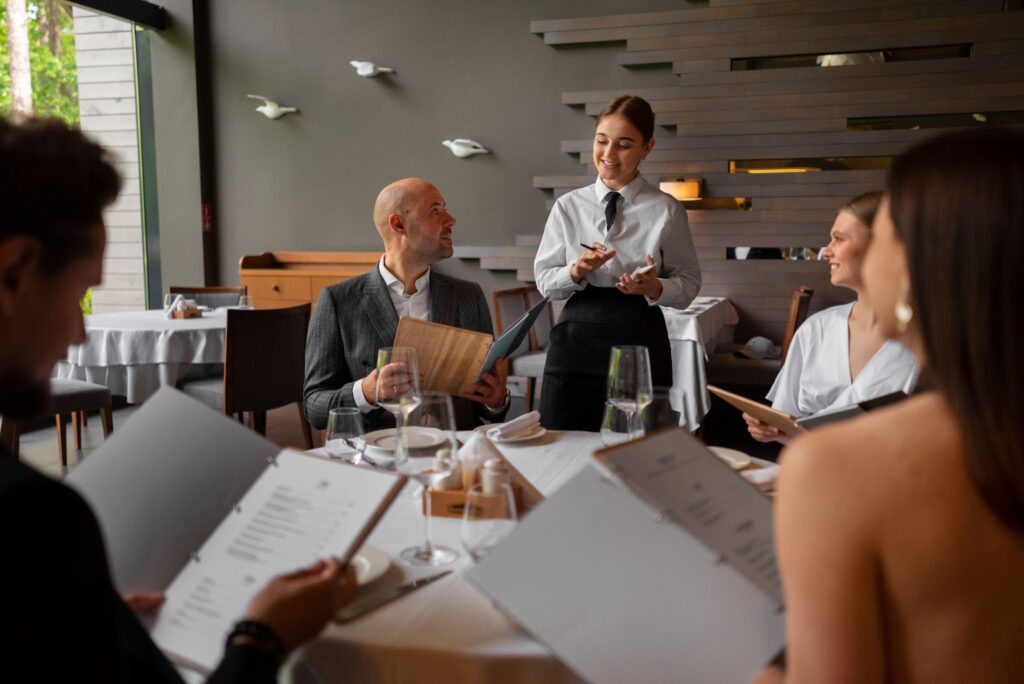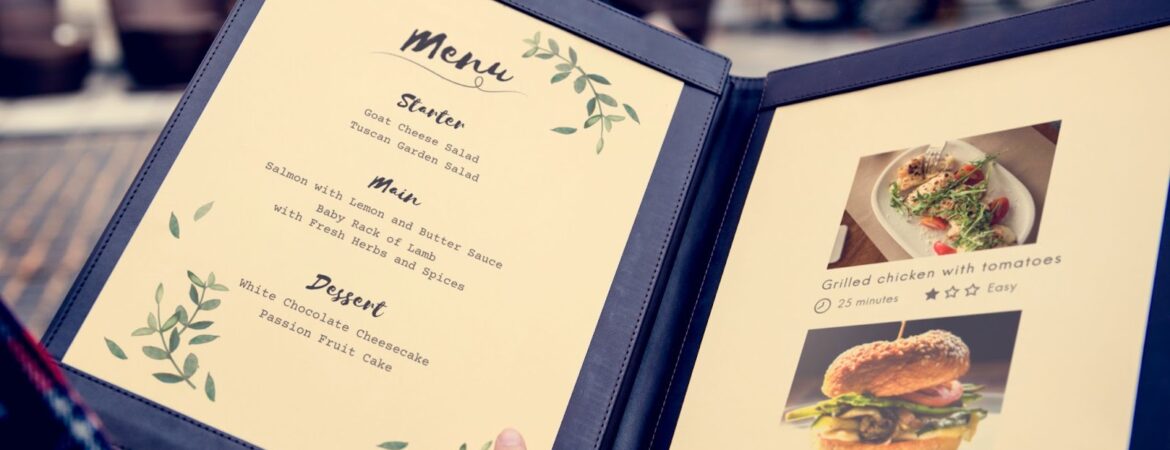In the realm of culinary arts, where tastes pirouette across the taste buds and scents seduce the olfactory senses, the way menus are described is pivotal in luring guests to venture into a gastronomic adventure. A masterfully composed menu description transcends simple language; it acts as a gateway to the gastronomic delight that awaits the guest. Whether it’s a sophisticated gourmet restaurant or a charming local bistro, the craft of articulating menu offerings is universally vital in enchanting both the desires and hunger of customers.
Framing the Culinary Journey:
The art of crafting an enthralling menu description begins with painting a vivid mental image that transports diners into the heart of the culinary experience. The role of the descriptive language extends beyond the dishes; it also mirrors the ambiance of the establishment.
Whether it’s the homely warmth of a rustic farmhouse or the avant-garde sophistication of a sleek urban bistro, the choice of words creates the gastronomic backdrop, setting the stage for an unparalleled dining experience. Words like “rustic,” “intimate,” or “city-inspired” become the brush strokes of your menu canvas, each hinting at the unique character of the setting and whetting the appetite for the gastronomic adventure that awaits.
By doing so, you not only succeed in preparing diners for the culinary journey ahead but also manage to encompass the essence of your establishment. This serves as a testament to the meticulous attention paid to the ambiance and the resulting dining experience, promising a harmonious fusion of flavor, presentation, and atmosphere.
Some points to keep in mind when setting the scene:
- Identify the unique aspects of the establishment’s ambiance. Is it vintage, modern, or fusion?;
- Choose adjectives that aptly describe the atmosphere;
- Ensure language consistency throughout the menu description to maintain a unified theme;
- Be truthful and authentic to build trust with diners.
Remember, a menu description that successfully sets the scene ultimately serves as an appetizer, stimulating the diner’s senses and enticing them into the main culinary event.
Crafting Captivating Imagery:
A well-crafted menu description goes beyond mere listing of ingredients; it serves as an artist’s palette, using vivid language to paint enticing pictures that ignite the imagination of the diners. Instead of simply stating the components, effective descriptions conjure up tantalizing visuals that arouse curiosity and whet the appetite.
Consider this example: rather than mentioning “grilled salmon with vegetables,” paint a vivid culinary picture. Try “A tender, flame-grilled salmon fillet, delicately perched on a medley of brightly colored, crunch-fresh harvest vegetables, all delightfully seasoned and adorned with a zesty citrus marinade.”
This enhanced description not only accentuates the ingredients of the dish but also kindles a visual of a sizzling salmon perched on a vibrant pile of fresh produce. It conjures an image that is hard to resist, making the dining experience seem so much more appealing and irresistible.
Few tips for crafting such descriptions include:
- Highlight the main ingredient(s), ensuring they are the star of the description;
- Be specific about the cooking methods used;
- Incorporate sensory words that engage the diner’s senses;
- Use adjectives economically, ensuring each one contributes to the overall image.
Crafting the perfect menu description is like creating a masterpiece, every detail adds to the culinary canvas, enticing the diner and making dining a vivid and memorable experience.
Emphasizing Elements:
Crafting compelling menu descriptions is a delicate balance between creativity and clarity. While imaginative language can create anticipation, clarity is crucial to ensure that the diners can discern the core components of the dishes. By prominently showcasing critical ingredients and their standout characteristics, diners are empowered with insightful information that aids their culinary decisions.
Instead of merely mentioning an ingredient, elucidate its uniqueness. For instance, instead of writing ‘served with potatoes’, say ‘accompanied by hand-selected, golden-fried, Idaho potatoes.’ This not only highlights the ingredient, but also emphasizes its quality and preparation method, enhancing its appeal to the diner.
Adjectives play a critical role in emphasizing the allure of the ingredients. Words like ‘succulent’, ‘crunchy’, or ‘melt-in-your-mouth’ can significantly amplify the attraction and appeal of the menu items.
Consider these tips when emphasizing the ingredients:
- Enumerate key ingredients upfront in the description;
- Describe the unique aspects of the ingredients, such as their origin, freshness, or quality;
- Use adjectives that amplify the appeal of the ingredients and the dish;
- Ensure that the description remains clear and easy to understand.
By effectively highlighting the ingredients, a menu description can not only elucidate the essence of dishes but also enhance their appeal, thereby elevating the overall dining experience.
Stirring the Sensory Symphony:
A standout menu description goes beyond the visual aspect to encapsulate a multi-sensory allure. It ingeniously employs evocative language that resonates with the diner’s senses of sight, smell, taste, touch, and hearing, creating a symphony of sensory excitement. This multisensory engagement makes the dish as tantalizing on the menu as it is on the plate.
Words such as “fragrant,” “delectable,” “silky,” or “resonant” can stimulate different senses and evoke a vivid gastronomic imagery, triggering cravings and whetting the appetite. For instance, instead of mentioning “cheeseburger with fries,” try “A generously stacked, succulent beef patty, topped with melt-in-the-mouth cheddar, all nestled in a lightly toasted artisanal bun. Paired with a side of crispy, golden fries that echo with every bite.”
Here are some points to consider:
- Use a diverse range of sensory words that touch upon all five senses;
- Choose words that evoke strong sensory reactions;
- Keep a balance between the sensory words to create a holistic picture;
- Ensure the sensory words align with the actual dish to maintain authenticity.
By orchestrating words that stir the senses, a menu description does more than just describe a dish; it immerses the diner in an authentic culinary experience even before they take the first bite.
Unveiling Culinary Chronicles:
Every dish is a culinary tale steeped in rich tradition, innovative ideation, and a dose of creativity. It’s these stories that breathe life into the food, making it more than just a combination of ingredients. Incorporating these narratives in menu descriptions adds an intriguing dimension, engaging diners intellectually and emotionally, and leading to a heightened appreciation of the culinary arts.
The story could revolve around the chef’s innovative experimentation, the intriguing sourcing of an exotic ingredient, or the historical importance of the recipe. For instance, a simple pasta dish could be described as, “Inspired by the quaint Italian towns, our chef has pieced together a traditional recipe that sings of the Tuscan sun – handmade pasta rolls, filled with fresh ricotta, and bathed in a soul-warming tomato ragù.”
Consider these points when weaving a story:
- Identify the unique aspects of the dish that can be narrated;
- Keep the story authentic and truthful to establish credibility;
- Ensure the storytelling complements the other menu description elements;
- Keep the story concise and engaging to maintain the reader’s interest.
By adding a dash of storytelling to your menu descriptions, you’re not only narrating the culinary journey behind each dish but also building a deeper connection between the diner and the food, enhancing the overall dining experience.
Why You Need Irresistible Menu Descriptions: Enhancing the Dining Experience”
In the competitive landscape of the culinary world, where restaurants vie for attention and loyalty, the significance of menu descriptions cannot be overstated. They serve as the gateway to your culinary offerings, offering diners a tantalizing preview of what awaits them. Here’s why crafting irresistible menu descriptions is crucial for enhancing the dining experience:
1. Captivating Attention:
In a sea of dining options, a well-crafted menu description is your chance to stand out. It’s the first interaction diners have with your dishes, and it must capture their attention amidst the myriad of choices available. Compelling descriptions draw diners in, piquing their curiosity and enticing them to explore further.
2. Setting Expectations:
Clear and descriptive menu descriptions help set expectations for diners. By accurately portraying the flavors, ingredients, and presentation of each dish, you create a sense of trust and transparency. This ensures that diners know what to expect when their meal arrives, reducing the likelihood of disappointment and enhancing overall satisfaction.

3. Enhancing Anticipation:
A well-written menu description has the power to evoke anticipation and excitement. By painting a vivid picture of the culinary delights that await, you spark anticipation and create a sense of eagerness to experience the flavors firsthand. This heightened anticipation can elevate the dining experience, making it more memorable and enjoyable.
4. Guiding Decision-Making:
Menu descriptions serve as valuable guides for diners navigating the menu. Clear and informative descriptions help diners understand the unique characteristics of each dish, making it easier for them to make informed decisions based on their preferences and dietary restrictions. This clarity simplifies the decision-making process and ensures a smoother dining experience.
5. Creating Emotional Connections:
Food is inherently emotional, and menu descriptions have the power to evoke a range of emotions in diners. By incorporating storytelling, evocative language, and sensory details, you create an emotional connection with diners that goes beyond mere sustenance. This emotional resonance fosters a deeper appreciation for the culinary experience and cultivates loyalty among diners.
6. Increasing Sales:
Well-crafted menu descriptions have a direct impact on sales and profitability. Studies have shown that descriptive menu items outsell their bland counterparts, with diners more likely to order dishes that are presented in an enticing manner. By highlighting the most appealing aspects of each dish and using persuasive language, you can effectively drive sales and maximize revenue.
7. Reflecting Brand Identity:
Menu descriptions play a crucial role in conveying your restaurant’s brand identity and culinary philosophy. Whether you specialize in farm-to-table cuisine, global fusion dishes, or classic comfort food, your menu descriptions should reflect the essence of your brand. Consistent messaging and tone ensure that diners have a cohesive experience that aligns with your restaurant’s identity.
Conclusion
Within the realm of gastronomy, the way a menu is described acts as an invitation to embark on a culinary journey, luring guests with the allure of taste, texture, and the artistry behind the dishes. Perfecting the technique of crafting menu narratives – from creating an immersive atmosphere and employing vivid imagery, to spotlighting key ingredients, stirring the appetite, and weaving in elements of storytelling – enables eateries to enhance the overall dining experience, making a memorable impact on their patrons. Through each meticulously chosen word, chefs and restaurant owners wield the ability to turn a mere list of dishes into a gastronomic work of art, beckoning guests to revel in the joys of exquisite food and delightful companionship.
